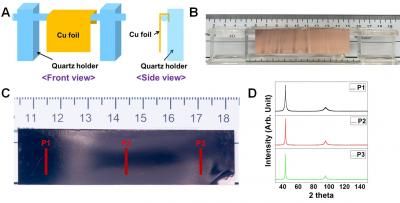Inorganic chameleon show promise in energy and nano research
Advertisement
A new PhD thesis from Chalmers University of Technology in Sweden shows that the multifaceted material perovskite could be of benefit in three key applications: fuel cells, gas separation prior to the storage of carbon dioxide and nanocomponents in electronic products. Consequently, the material can be of significance to both energy systems of the future and the development of nanoelectronics. Perovskite is a structure type that consists of three different components: alkaline earth metals such as calcium, transition metals such as iron and negative ions, which are often oxygen. perovskites are usually described as inorganic chameleons as they are very flexible and can exhibit different properties depending on their environment. They are easy to manufacture, and by varying the structure, new interesting functions can be created in the material. In her recently published PhD thesis at Chalmers Annika Eriksson has studied the link between these new functions and the structure of perovskites. She has, among other things, examined a group of perovskites which have good conductive properties for both oxygen ions and electrons. These properties are sought after as cathode material in fuel cells. Present-day fuel cells have a working temperature of 800-1,000°C. They therefore have limited areas of use and require a great deal of energy to heat up. "One aim is to be able to reduce the working temperature to a more manageable level in the range 300-600°C," says Professor Sten Eriksson, who was the supervisor for the thesis. "We also hope that new perovskites can offer a longer lifespan and better conductive capacity for ions and electrons in fuel cells." A supercell structure of an oxygen-deficient perovskite. The supercell structure contains voids, or holes, which make it possible for oxygen ions and/or electrons to move. In doing so, the perovskite can function as a conductor for both ions and electrons. The fact that perovskites conduct oxygen effectively also means that they can be used in membranes for the separation of oxygen from other gases. An interesting application could be carbon dioxide storage in bedrock, a potentially very important form of technology to slow down climate changes. Before the carbon dioxide is pumped into the bedrock, other gases, including oxygen, must be removed from the gas mixture. Annika Eriksson has also examined a group of perovskites which are multiferroic materials, also known as multifunctional materials. This means that they are spontaneously polarisable in an electric field and at the same time they have magnetic properties. Materials of this kind are important in nanoelectronics research as they can combine polarised and magnetic effects in one circuit.
Most read news
Topics
Organizations
Other news from the department science
These products might interest you

Anopore™ by Cytiva
Precise filtration made easy with Anopore inorganic membranes
The aluminum oxide filter membrane that can increase the purity or yield of your analyte

Hahnemühle LifeScience Catalogue Industry & Laboratory by Hahnemühle
Wide variety of Filter Papers for all Laboratory and Industrial Applications
Filtration Solutions in the Life Sciences, Chemical and Pharmaceutical Sectors

Get the chemical industry in your inbox
By submitting this form you agree that LUMITOS AG will send you the newsletter(s) selected above by email. Your data will not be passed on to third parties. Your data will be stored and processed in accordance with our data protection regulations. LUMITOS may contact you by email for the purpose of advertising or market and opinion surveys. You can revoke your consent at any time without giving reasons to LUMITOS AG, Ernst-Augustin-Str. 2, 12489 Berlin, Germany or by e-mail at revoke@lumitos.com with effect for the future. In addition, each email contains a link to unsubscribe from the corresponding newsletter.































































